
New Audi supercoupe battles Porsche & BMW… Audi’s 394bhp TT RS takes on BMW’s M2 and Porsche’s new flat-four 718 Cayman S on road, track and runway. But are any of these £50,000 sports coupes worth your money? Great Expectations. Photography by Dean Smith. Audi claims its latest TT RS is a serious contender, Porsche that its new fourcylinder 718 Cayman S is still the pick of its class, while BMW’s M2 has all the ingredients to be the best £50k sports coupe of all. So which wins the fight?
AUDI TT RS GROUP TEST
On road Northy York Moors by Adam Towler
The little orange Porsche’s flat-four thumps coarsely at idle from just behind my kidneys. For once, I am oblivious to it. I am completely transfixed by an Audi TT seemingly heading for a massive accident. Up ahead, road test editor Dan Prosser is getting the new TT RS out of shape for Dean Smith’s camera on the far hairpin of Bedford Autodrome’s West Circuit. The TT dives aggressively into the corner then pitches nose up as Dan gets committed with the throttle, markedly gaining speed in the process. Suddenly the tail yaws to the side, by perhaps 25 degrees but no more, and then it stays locked onto that drift angle, still gaining speed, the front wheels almost straight, the rears spinning up, engine howling. However, there is no accident: this is just what the new TT RS does under power. Already I get the distinct feeling it may be a TT unlike any other.
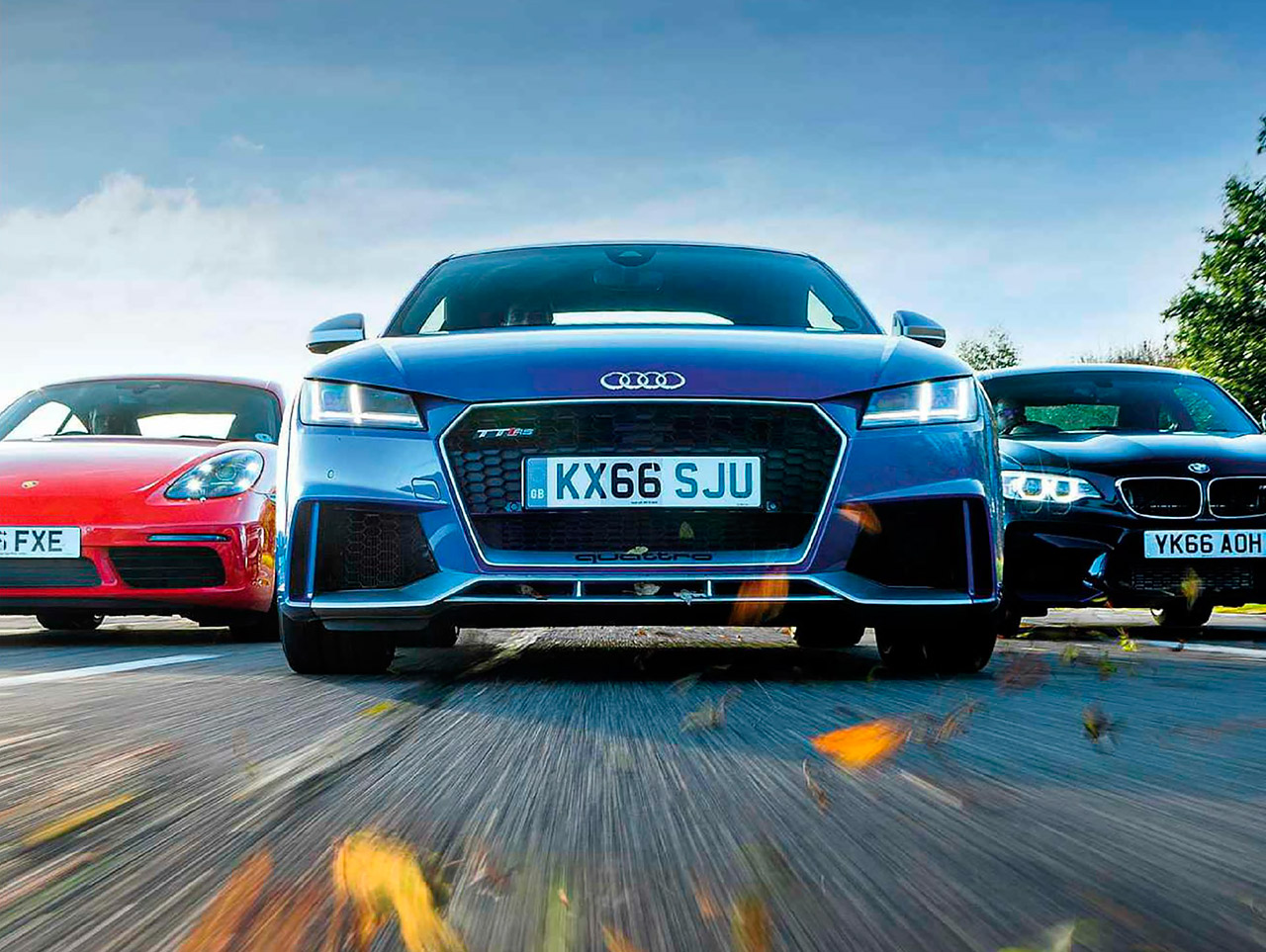
Right. Focus. There’s a 718 Cayman S to be driven, and while slippery conditions mean we’ve decided to abandon going for lap times today, the session reminds us all why Porsche’s midengined coupe is a wondrous thing. It’s so agile and delicate, and when specced with a limitedslip diff, as it is here, the Autodrome’s greasy surface is an unintimidating giggle. If you’ve got around £50,000 to spend on a new sports coupe that requires no compromise in daily use, the Cayman S surely remains the default choice.
Or does it? Two contenders suggest otherwise, so over the next three days we intend to really drill down into what each of our trio offers. After slithering around the Autodrome, we’ll head to the North York Moors for a day, stop off at Blyton Park for another attempt at some lap times (pray for dry tarmac), then visit Bruntingthorpe to gather some straight-line data. By the end of it we should know if four, five or six cylinders is the magic number.
When we finally leave the Bedford Autodrome it’s freezing cold and dark, and the prospect of being on the North York Moors before our hostelry’s kitchen closes for the night seems of utmost importance. Writer’s privilege means I get the pick of the cars, and out of curiosity I elect for the newcomer.
I’m soon gazing longingly at the glowing tail lamps of the third car here – a BMW M2 F87 – because I just can’t get comfortable in the TT RS. Given that our limbs come in all shapes and sizes, this may not apply to you, but Dan will later admit to the same problem: the flatbottomed wheel doesn’t extend near enough to the driver, so to avoid stretching I’m sitting too near to the pedals, and my right leg and hip are soon singing away merrily.
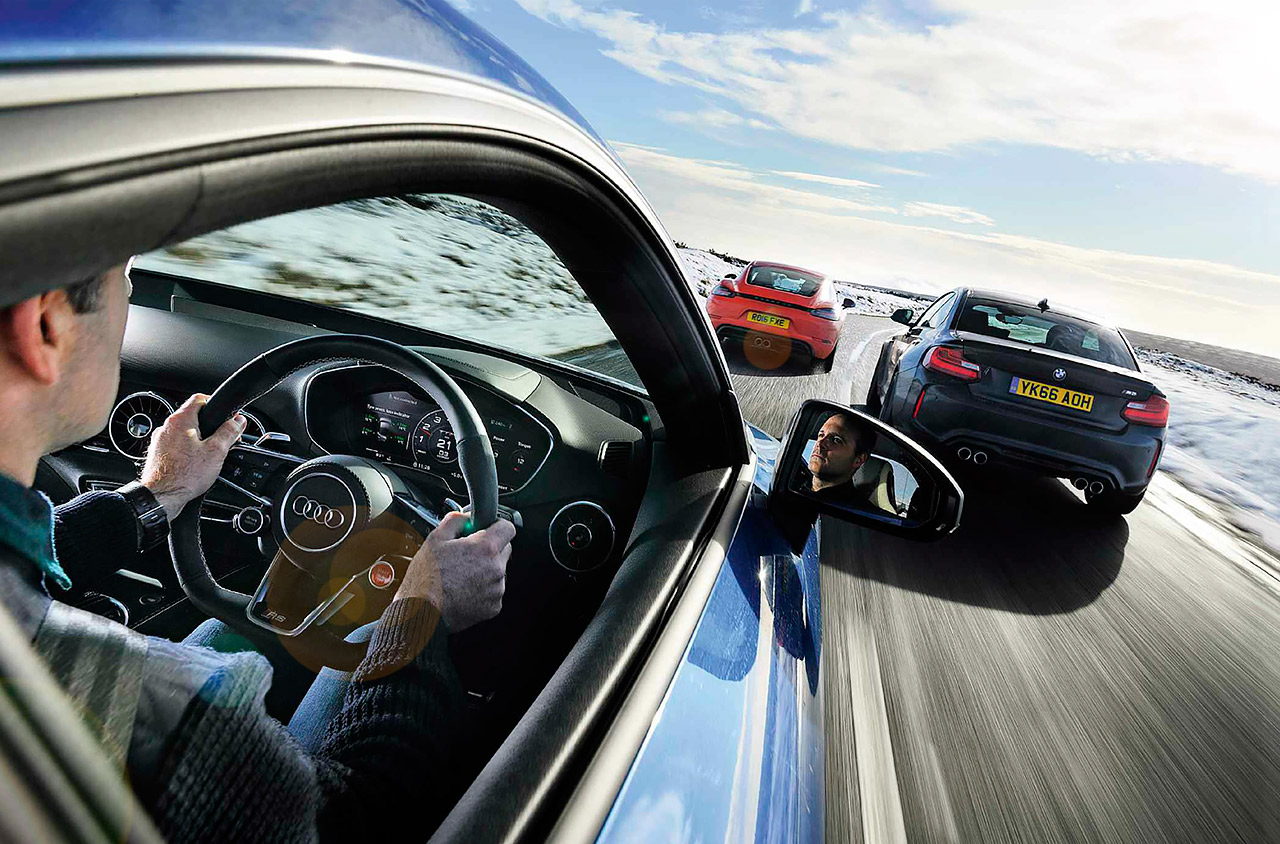
Above: the 718 has a chassis to die for, but has Porsche’s decision to drop two cylinders killed the Cayman’s appeal? Right: the BMW M2 suffers from a different problem, especially on the choppy roads of the North York Moors – it simply won’t settle.
You’d hope for much better from a car that costs £51,800. That’s a lot of money for what aesthetically appears to be little more than a TT with a more elaborate – some might say too elaborate – bodykit. This particular, highly specced example costs £68,830, making it the most expensive here. That’s an Audi TT, note, for nearly seventy thousand pounds.
What you’re really paying for is the engine. The TT RS is all about its in-line five, now more potent at 394bhp and 354lb ft, and lighter by 26kg (with a further 2kg saved in the sevenspeed S-tronic dual-clutch transmission – the only choice of ’box). Overall the car weighs 1440kg. You’re also getting a very serious set of brakes, with 370mm discs on the front axle and eight-pot calipers. With their stainless steel pins adjoining disc to hub, they look extraordinary, and promise considerable endurance.
It’s soon apparent that the Audi’s steering is curiously inert in its default setting, with very little self-centring action, but it feels much more accurate in Dynamic, which bodes well for tomorrow – once we’ve fiddled around with the Individual settings. Our car runs on optional 20-inch rims, their oversize nature in relation to the body giving the car the lofty, almost cartoon-like appearance of a Hot Wheels toy. Without the optional Magnetic Ride suspension the ride quality would no doubt be challenging, but in Comfort or Auto the variable dampers do just enough to take the edge off the worst of the intrusions. Nevertheless, the TT RS rolls along with a constant aura of pent-up tautness, like a coffee addict queuing for their first espresso of the morning. It’s a sensation thrown into sharp relief by the far more relaxed Porsche.

The 718 Cayman S is cheaper in basic form – £48,834 – but suffers the same dramatic inflation here with options, taking it to £67,656. But where the Audi’s extras seem largely trivial in the main – £650 on a gloss-carbon engine cover? – the Porsche’s are largely about go, not show. Amongst a long list, this Lava Orange car has the 20mm-lower sports suspension with PASM (£1133), torque vectoring and a mechanical limited-slip differential (£890), PCCB ceramic brakes (£4977) and a sports exhaust (£1328 – a questionable expenditure, as we shall see). It’s either extra money more fruitfully spent or highlights the traditional stinginess of Porsche’s standard equipment list.
The little four-cylinder engine benefits from the same sort of variable-vane turbocharger tech as the 911 Turbo and makes 345bhp and 310lb ft from its 2.5 litres. At 1355kg it’s usefully the lightest car here and shares nothing with any more humble platform. Somewhere behind us in the murk the Cayman’s driver is also complaining about its expensive fixedback bucket seats, but I know from previous experience that without them it’s a surprisingly habitable machine over long distances.
If nothing else, the BMW M2 is a comparative bargain, starting at £44,080 and matching here the Audi’s basic price at £51,800 thanks to some more sensible options, including £2645 spent on a seven-speed M DCT ’box. Personally, I was desperate for BMW to send us a manual (as Porsche did), but a twin-clutcher makes for an appropriate foe for the Audi. With 365bhp and up to 369lb ft on overboost, the M2 needs all the torque it can muster given it’s also the heaviest at a disappointing 1520kg, despite its diminutive dimensions. Oh, and yes, the kitchen has closed when we eventually arrive.
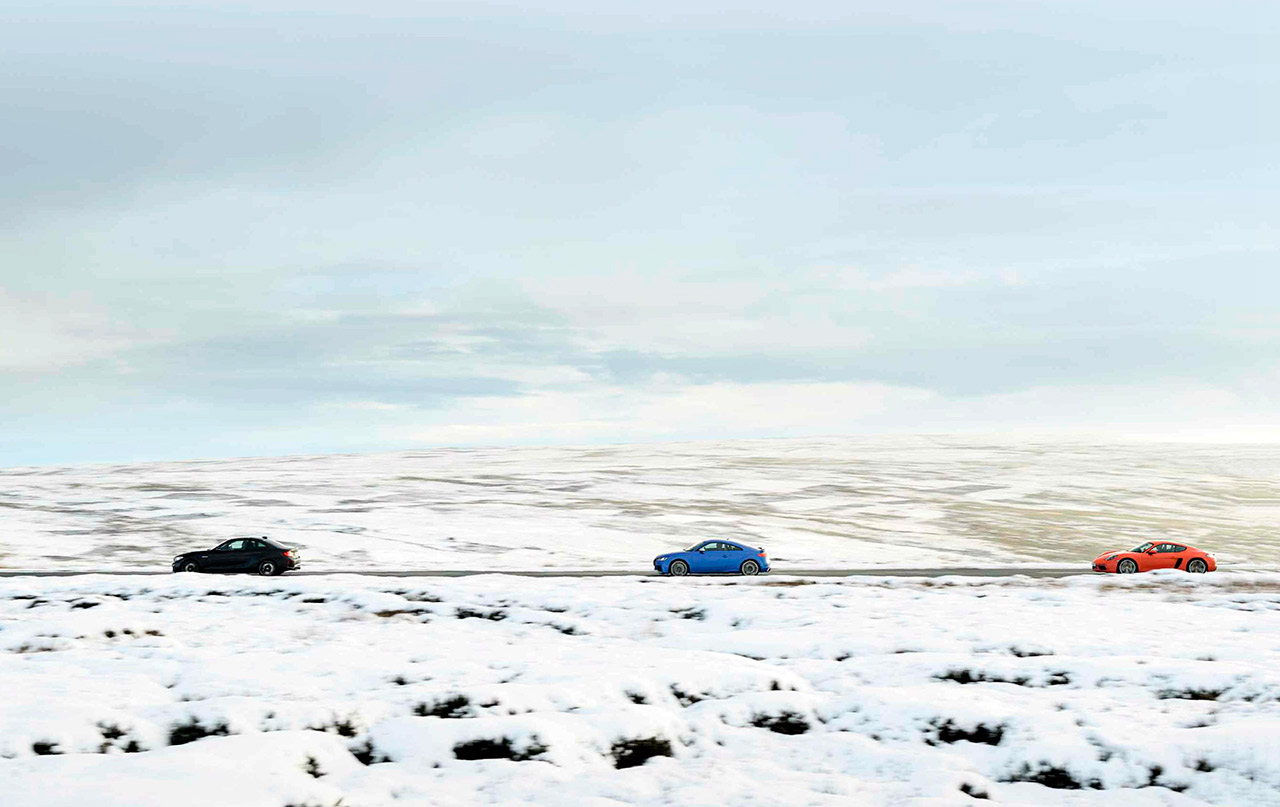
The next morning I awake early to the sound of rain thrashing incessantly against our inn’s window. Audi conditions. The TT RS starts with a smirk-inducing ka-boom and then gurgles with a note so thick it gnaws at your ears like the wintry air. To be fair, the BMW isn’t far behind for cold-start theatre, with a rich growl of its own, but the Porsche… Well, the 718 just chugs with a tone somewhere between an unsilenced air-cooled Beetle and a Hawkeyeonwards Impreza Turbo.
There’s a typically foolproof quality to the TT in these conditions that positions it as a different proposition to the other two. You can feel it continually losing grip at each corner, but what slippage there is remains fleeting, and peeling back a layer of ESP protection sees the Audi’s acceleration unaffected by any loss of traction or electronic nursing.
And what acceleration it is. The motor is outrageously muscular, with that deep-chested rumble rising dramatically to a fraught, nearhysterical bark so characteristic of a heavily boosted five-pot. Overtaking is ludicrously easy; it’s a gap-commit-growl-gone process, time after time. All it needs is an overlaid scream of pace notes from Christian Geistdörfer to complete a thoroughly authentic Group B soundtrack. I’ve driven the M2 before and I know what to expect, but that doesn’t stop me aching to drive it every time I catch sight of it. It has the truncated dimensions and the bluff but overpowered-for-its- size look of a harbour master’s tugboat.
Proceedings in M-land begin promisingly, for it sounds keen and gruff in an insistently aggressive fashion. I glimpse the bulging rear arches in the mirrors, wriggle that bit more snugly into the supportive driver’s seat and pitch into the first, long, sweeping curve. Yet within moments, the M2 proposition begins to unravel with all the depressing familiarity of other recent BMW M-department products. This needs careful context. If you regularly have the use of a racing circuit all to yourself and an unlimited supply of new tyres, you will love the M2. We adored it at the Bedford Autodrome because it’s brilliant at playing the hooligan.

In fact, I concede that an M2 on warm, smooth roads is probably very effective indeed, and if you’re the sort of driver who has infinite faith in a car’s ability to turn in come what may, you may also fall for its charms. But here’s the rub: on a textured stretch of tarmac, in poor weather, the M2’s talents do not necessarily translate. That typically fat, squidgy M steering wheel does its best to dampen the negligible feedback from the front axle. Turn in and the weighting never changes, so there’s nothing to reassure you the nose is sticking. And like its bigger brothers, the M2 does get uncomfortably lively at the rear.
That infernal rear axle is always on the move, constantly squirming for grip, shuddering around. These fast moorland roads are characterised by their varying amplitude as well as their direction changes, and the M2 hates them, picking up one or both rear wheels over every crest, sometimes snatching violently one way or the other. It’s a phenomenon constantly needled by the powertrain. The straight-six boosts early and with real ferocity, and the M DCT ’box loves to bang in the next gear harshly when changing at high revs and full throttle.
The secret is to transfer weight to the rear via the throttle as soon as possible, shortening the turn-in phase of a corner, because as soon as you’re back on the gas the M2 feels a lot more settled and the steering isn’t an issue. The dampers soon get switched back from Sport to Normal – they’re far too stiff for these roads, and even in Comfort the M2 can pogo – but I still long for the engine to have more energy higher up the rev band and to not make a monotone grrrr whatever it’s doing…
After the M2, the Audi is a revelation. There’s little to signpost its impending ability other than ‘fast’ steering, which initially feels like a ruse to disguise a lot of engine in the nose. It’s not. The TT RS gets better the harder you drive it.
While the theatrics at the Bedford Autodrome simply aren’t relevant on the public road, it is possible to trail-brake the RS into a corner to an amusing degree, the tail swinging out wide and the nose biting right into the apex. From here it’s straight onto the power, and while there’s not much more you can do after that to alter your line, the RS resists understeer to an astonishing extent. Hook it all up together, including the incredible resilience of those massive brakes, and the TT RS cuts across the ground at a scintillating pace. ‘It’s the best and most enjoyable TT I’ve ever driven,’ says Prosser while we stare at the car in a mixture of awe and surprise. ‘So much better than the RS3 – it actually feels light and alert and agile.’

Time, then, for the neatly restyled Porsche and its impossibly crisp panel pressings, which must make manufacturing engineers everywhere flush with excitement. We talk so much in these pages about ‘feel’, about how a car flows down a road, and of control weights. And guess what?
We’re about to go on about that touchy-feely stuff again. Drive the same section of road in the Cayman and the nervousness, the busyness of the M2 is immediately notable by its absence. That doesn’t make the Porsche dull, but it does have the effect of putting the driver immediately on the offensive. No longer are you mopping up minidramas, rather you’re picking a line, adjusting it mid-corner, willing there to be more corners just so you can take them on. Push really hard over a bumpy stretch of road and the 718 finally starts to get busy controlling those 20-inch rims, but 90 per cent of the chassis’ efforts are expended into nothing more than background noise, and it never alters your chosen line. The steering is brilliant in its accuracy – more so than ever – and good in its communication, but it’s all about being sat deep within the wheelbase, centre of gravity on the deck. It’s this disarming poise that will make you grin wickedly while driving this car.
What will make you grimace grotesquely is the engine. The kindest thing you can say about the new motor is that it makes the Cayman S a seriously fast car. The arrival of boost swells the torque in that recognisable variable-vane manner, making the Porsche feel even lighter than it already is. Driven in isolation its performance is certainly impressive, although it’s a shock to drive in convoy with a TT RS and be left gasping in a straight line. In such a situation it’s necessary to use all of the four-cylinder engine’s performance, and that means hanging on to gears, which is where the engine’s issues intensify. The 718’s gearing is long: it’ll pull an indicated 81mph in second gear, and this exaggerates the surprising lethargy at low revs, because the engine does very little below 2500rpm. It also means a lot of time spent in the upper reaches of the rev range, and here this engine is belligerently harsh, uncomfortably loud and almost completely devoid of charm. Do you get used to it over time? Maybe. It’s certainly different; it undeniably has character.
‘What’s going on here?’ says Prosser in bemusement after a stint in the 718. ‘There’s lots of performance and it’s very muscular through the mid-range, but I hate the soundtrack and there’s no drama or excitement in the delivery.’ He’s right. After the beauty and unique qualities of the old naturally aspirated sixes, this should start a riot.
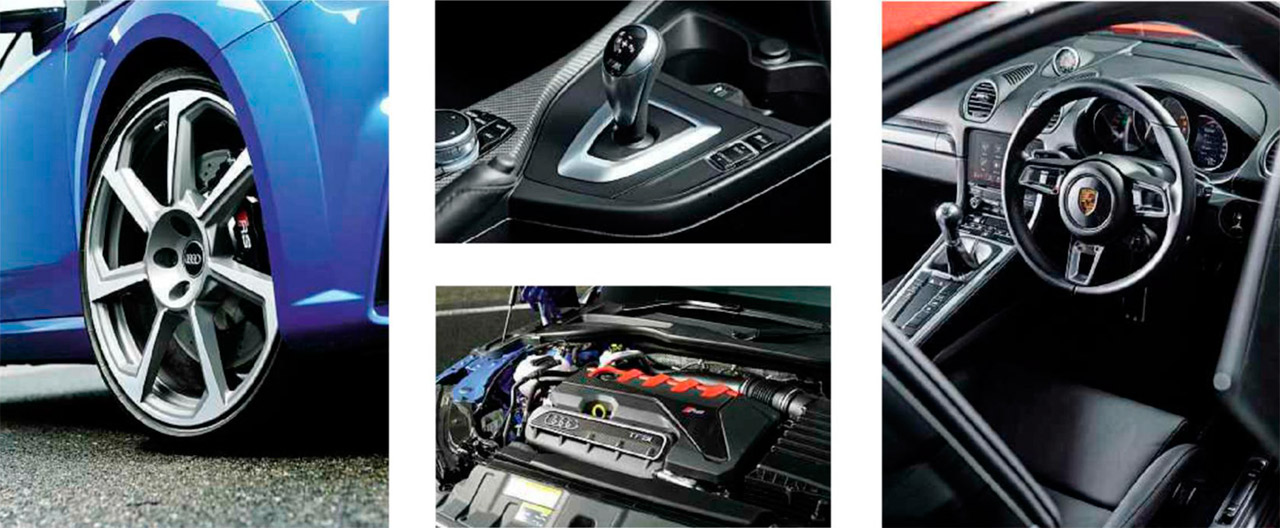
Soon enough, a conclusion materialises out of the moorland mist that’s hung around all day and is now closing in. If you regularly need the use of back seats and value a reasonable boot, the only car for you here is the M2. That it also looks amusingly tasty, is effortlessly rapid, largely enjoyable to drive and comfortable over distance makes it a sound all-round proposition. But come on, to justify those M stripes it should be more than that. It is perhaps naïve to expect a 2-series-based machine to compete head-on with a bespoke sports car – we do ‘get’ that – but the M2 isn’t just behind on ultimate ability, it still seems to exist in a hinterland between an M Performance BMW and something like the wild M4 GTS. I want to love it, but I no more than like it.
The Audi? I don’t know about you, but £50,000- 70,000 seems an awful lot of cash for a hatchbased coupe that’s unfailingly ubiquitous in its more standard form. If only the TT RS had some box arches in Audi tradition. In short, if only Audi had matched BMW’s aesthetic effort.
Nevertheless, the TT RS is saved by two key attributes, and I expect you’ve probably gathered what they are by now. Firstly, its unique engine delivers a soundtrack and a level of pace that borders on the narcotic, encouraging an absurd blindness to the price. Secondly, it’s surprisingly entertaining to drive, if a bit one-dimensional in the long term. In essence the TT RS is like a mutant hot hatch, a ‘hot hatch plus’, if you like.
So the Porsche takes it, right? Yes, just. But it’s a depressingly hollow victory. No longer can I imagine signing on the dotted line for a Cayman S with my own money. Nearly everything about the 718 sparkles like a jewel, but the engine is a most uncharacteristic fumble by Stuttgart. Don’t think for one moment this is us getting all rose-tinted over the six-cylinder motor. That would grossly underestimate where the 718 Cayman S falls short, because we’re not only talking about the fluffily abstract notion of appealing sound, but the far broader spectrum of harshness and vibration, delivery, even kerbside manners.
More than anything, this test reaffirms our belief that the 718 Cayman simply must gain a genuine mass-market rival at this price point. A proper sports coupe, but one also designed and built in such a way that it can appeal to almost anyone, and ask for next to no compromises in return – such a difficult trick to pull off.

It must surely weigh 1400kg or less, and not hide behind the convenient ‘roadster’ caveat; no metal folding hard-tops, overly wide tyres, overly long wheelbases or platform compromises. The Cayman is vulnerable, but until such a time when there’s a rival to meet it head on, its rule continues. But are there better ways to spend your £50k? Look at lightly used cars rather than brand new and that sum could buy you something truly special, as we’ll discover in a few pages’ time…
It’s chilly and wet when we arrive at Blyton Park with the TT RS and its rivals. Our second attempt to bag some dry laps has also been thwarted, but today we’ll unpack the VBOX and press on regardless. With the ambient temperature around nine degrees the tyres stand a chance of working, but with the track slick from overnight rain this is going to be not only a test of traction but also of balance and progressive breakaway characteristics.
For consistency’s sake we’ll drive with ESP disabled on all three cars. Not just because doing so reveals their true on- and over-the-limit traits, but because a few exploratory laps with electronics active shows the systems are too restrictive to permit decent lap times, even in their most generous modes. Seat of the pants it is, then.
‘I know what to expect of the M2 F87, but that doesn’t stop me aching to drive it every time I catch sight of It’
‘The Audi rolls along with a constant aura of pent-up tautness, like a coffee addict queueing for their first espresso of the morning’
It only takes a few corners to deduce the M2 is going to have a fight on its hands. The lack of traction isn’t a great surprise, but it is a hindrance. The bigger problem is the abruptness with which traction is breached. A tendency to oversteer on turn-in doesn’t help matters, so you’re always chasing the M2’s tail. That sounds worse than it is, but every slip, slide and flurry of wheelspin wastes precious tenths at every corner.
You need to be quick to stay on top of it, but ironically the steering is a little too responsive, forcing you to do that trickiest of things: make sharp, precise inputs. What tends to happen is you sometimes overcorrect, which makes for scrappy progress.
It’s definitely exciting, but not a car you can relax with for a moment, at least when showing it full commitment against the clock. The resulting 1:11.60 is hard won, but not, I suspect, hard to beat.
The inclement weather plays to the TT RS’s strengths, but the Audi isn’t at home on track. It puts down the rampant fivecylinder motor’s power and torque to terrific effect: a look at the data trace shows that whenever the wheels are straight, the TT romps away. There’s grip to lean on in the corners, too, but when you do eventually find the limits of traction and lateral grip, it needs careful handling. The chicane that feeds you into the long, crucial lefthander at Lancaster highlights the TT’s propensity to oversteer on a closed throttle. Quick direction changes have a kind of Scandinavian-flick effect, which needs steering lock, throttle and a fair bit of space to catch.
‘The Cayman’s disarming poise will make you grin wickedly while driving it’
Consequently you tread a fine line between working just to the TT’s limits and going way over them. The former is hugely effective, but not much fun; the latter needs space for the Haldex all-wheel-drive system to sort things out. What sweet spot there is between those two is fleeting and inconsistent, but the RS’s 1:10.35 is hard to argue with.
And so to the Cayman S. A mid-engined car with lots of torque should be a handful – at least in theory – but the Porsche is far and away the nicest, most exploitable and most enjoyable car to push for a time. It’s also the only stick-shift car here, which probably costs it a few tenths but immediately makes it more fun.
The four-cylinder engine works well, summoning strong torque across a broad rev range, and the carbon-ceramic brakes are the best of the bunch, both for feel and ABS intervention. The conditions are so slippery that all three cars rely heavily on their antilock- braking systems. Frustratingly, on the Cayman’s best lap I’m actually a bit timid on the brakes at the end of the straight, which probably costs a tenth or two.
The 718 doesn’t have the traction of the TT, but it’s progressive when the rear end does break away under acceleration. It also has truly sublime balance. Nowhere more impressively than the fast right-left at Port Froid, where it carries and sustains considerably more speed because the rear axle is so much better planted. Of the three, it’s the car I want to stay out in and keep lapping, which speaks volumes, even if the eventual best of 1:11.01 hands a convincing win to the TT RS.
Straight-line performance
Bruntingthorpe by Dan Prosser
The Audi TT RS is such an undemanding car to launch off the line that an obedient spaniel could be trained to set sub-four- second 0-60mph times in the space of an afternoon. Select Dynamic mode, switch off the stability control and leave the transmission in auto to engage launch control, then watch in awe as the RS pings itself to the singlecarriageway national speed limit in 3.4 seconds.
Has so little effort ever been expended while running two-tenths shy of a McLaren F1? On a dry but chilly surface the TT RS’s four-wheel-drive system finds so much traction that not a single bhp goes to waste. Also equipped with a twin-clutch transmission and launch control, but driving two wheels only, the BMW M2 is more than a second slower to 60mph. Still, 4.5 seconds is fairly rapid, but with a useful mid-engined traction advantage the Porsche 718 Cayman S goes a tenth quicker, despite the limitations of its manual gearbox. By 100mph the Audi leads both rivals by more than two seconds.
The TT RS is the quickest off the line, then, and it has more roll-on performance, too, sprinting from 50 to 100mph in fourth gear in 7.3 seconds compared with 8.4 seconds for the M2 and 8.1 seconds for the Cayman.
You can see the full breakdown over the page.
The TT’s drift mode
The new TT RS has a drift mode. Audi doesn’t mention such a thing in any of its literature and you won’t see a button anywhere in the cabin marked ‘DRIFT’, but trust me, it’s there. Turn into a slippery corner on circuit, wait for the front axle to stick, then stand on the throttle.
The car’s four-wheel-drive system can send 100 per cent of the torque to either axle, and in this scenario it’ll overload the rear wheels so dramatically that the car will swing out into a wide, sweeping four-wheel drift. You barely need to dial in any corrective lock because the car will soon catch the slide itself by diverting drive forwards. It feels exactly like the much-debated drift mode on the Ford Focus RS, in fact. The Audi won’t pull of the same trick on a dry circuit – not willingly, anyway – and disappointingly there’s never any sense of on-throttle adjustability on the road. But this is the first TT to exhibit any sort of playful behaviour whatsoever, and that’s as significant a development as any other that Audi might care to shout about.
TECHNICAL DATA Porsche 718 Cayman S 982
Engine Flat-four, 2497cc, turbo
Power 345bhp @ 6500rpm
Torque 310lb ft @ 1900-4500rpm
Transmission Six-speed manual, rear-wheel drive, LSD (option), torque vectoring (option)
Front suspension MacPherson struts, coil springs, adaptive dampers (option), anti-roll bar
Rear suspension MacPherson struts, coil springs, adaptive dampers (option), anti-roll bar
Brakes Ventilated carbon-ceramic discs (option), 350mm front and rear Wheels 8.5 x 20in front, 10.5 x 20in rear (option)
Tyres 235/35 R20 front, 265/30 R20 rear
Weight 1355kg
Power-to-weight 259bhp/ton
0-62mph 4.6sec (claimed)
Top speed 177mph (claimed)
Basic price £43,834
On sale Now
Rating: 4++
{module Porsche 718 982}
TECHNICAL DATA BMW M2 F87
Engine In-line 6-cyl, 2979cc, turbo
Power 365bhp @ 6500rpm Torque 369lb ft @ 1450-4750rpm
Transmission Seven-speed dual-clutch (option), rear-wheel drive, LSD
Front suspension MacPherson struts, coil springs, adaptive dampers, anti-roll bars
Rear suspension Multi-link, coil springs, adaptive dampers, anti-roll bars
Brakes Ventilated discs, 380mm front, 370mm rear
Wheels 9 x 19in front, 10 x 19in rear Tyres 245/35 ZR19 front, 265/35 ZR19 rear
Weight 1520kg
Power-to-weight 244bhp/ton
0-62mph 4.3sec (claimed)
Top speed 155mph (limited)
Basic price £44,080
On sale Now
Rating: 4+
{module Bmw 2 Series Coupe}
TECHNICAL DATA Audi TT RS 8S
Engine In-line 5-cyl, 2480cc, turbo
Power 394bhp @ 5850-7000rpm
Torque 354lb ft @ 1700-5850rpm
Transmission Seven-speed dual-clutch, four-wheel drive, Torsen differential (rear)
Front suspension MacPherson struts, coil springs, adaptive dampers (option), anti-roll bar
Rear suspension Four-link, coil springs, adaptive dampers (option), anti-roll bar
Brakes Ventilated discs, 370mm front, 310mm rear
Wheels 9 x 20in front and rear (option)
Tyres 255/30 R20 front and rear
Weight 1440kg
Power-to-weight 278bhp/ton
0-62mph 3.7sec (claimed)
Top speed 155mph (limited)
Basic price £51,800 On sale Now
Rating: 4+
{module Audi TT 8S}
| Speed (mph) | 10 | 20 | 30 | 40 | 50 | 60 | 70 | 80 | 90 | 100 | 110 | 120 | 130 | 140 |
| Audi | 0.6 | 1.0 | 1.5 | 2.0 | 2.7 | 3.4 | 4.3 | 5.4 | 6.6 | 8.1 | 9.9 | 11.8 | 14.3 | 17.5 |
| BMW | 0.9 | 1.4 | 2.1 | 2.8 | 3.5 | 4.5 | 5.6 | 6.9 | 8.4 | 10.2 | 12.4 | 15.0 | 18.1 | 22.2 |
| Porsche | 0.7 | 1.3 | 1.9 | 2.4 | 3.5 | 4.4 | 5.4 | 7.1 | 8.5 | 10.2 | 12.8 | 15.0 | 17.7 | 21.7 |
| Speed (mph) | 30-50 | 40-60 | 50-70 | 60-80 | 70-90 | 80-100 | 90-110 | 100-120 |
| Audi | 3.6 | 2 .7 | 27 | 2 .8 | 30 | 3 .2 | 3. 4 | 37 |
| BMW | 3.2 | 2 .9 | 30 | 3 .1 | 3. 5 | 3 .8 | 4. 2 | 51 |
| Porsche | 4.3 | 3 .3 | 31 | 3 .1 | 3. 2 | 3 .4 | 3.8 | 4. 2 |
{module Braking 100-0mph}
On track Blyton Park by Richard Meaden

LAP TIMES
• Porsche 718 Cayman S 982 – 1:11.01
• Audi TT RS 8S – 1:10.35
• BMW M2 F87 – 1:11.60
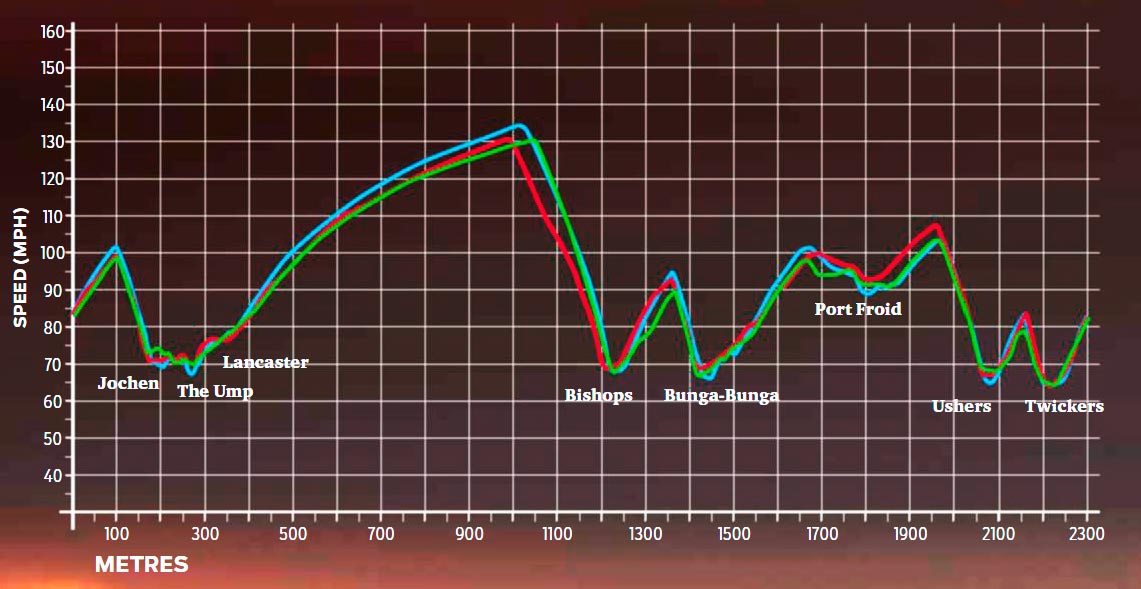
‘THE INCLEMENT WEATHER PLAYS TO THE TT RS’S STRENGTHS, BUT THE AUDI ISN’T AT HOME ON TRACK’
{CONTENTPOLL [“id”: 90]}





